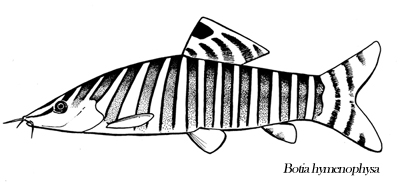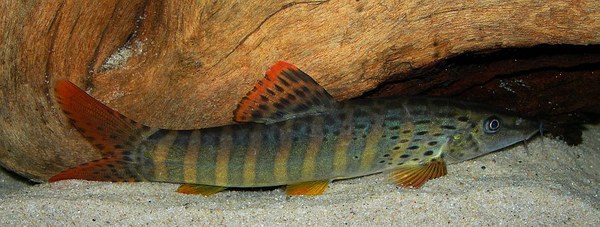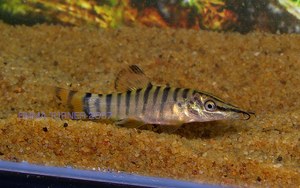Telling Tigers Apart - The Syncrossus Genus
Originally written as "The Tiger Botias of the Hymenophysa Group" by Kamphol Udomritthiruj.
Revised with nomenclature changes and updates by Martin Thoene, (November, 2006)
This article is intended to help the aquarist visually key and identify loaches that, excluding body patterns, are very similar in morphology and meristics. That is, the measurements (fin rays, lengths, depths, counts, etc.) in this group of loaches have enough variation as to overlap and statistically be indistinct from each other. These would include the Syncrossus species hymenophysa, helodes, beauforti, berdmorei, reversa, and an unidentified species (cf. berdmorei) pictured here for the first time anywhere outside Thailand.
The only easy distinguishing characteristics between these species are their body colors and markings.
About eleven years ago, I wrote an article entitled “The Tiger Botia, B. hymenophysa (Bleeker, 1852) or B. helodes Sauvage, 1876?” for the Greater Seattle Aquarium Society’s publication Northwest Aquaria (Vol. 11, 1989). It seems strange that after all this time nothing has changed much in the misidentification (in the aquarium trade and literature) between the now re-named Syncrossus helodes and S. hymenophysa. This is largely due to popular aquarium literature which usually has S. helodes labeled as Botia (Syncrossus) hymenophysa.
In the revision of Indochinese fishes described by the nineteenth century ichthyologist Henri-Emilé Sauvage (1844-1917), Kottelat (1984) revalidated the status of Botia helodes as being distinct from B. hymenophysa.
In his 2004 revision of Botinae, Kottelat renamed what was then known as the Hymenophysa Complex, Syncrossus.
One of the prime differences between the two loaches is their geographical distribution; Syncrossus (Botia) helodes is found in Laos, Vietnam, Cambodia, and in Thailand, whereas, S. hymenophysa is found in Indonesia (Sumatra and Borneo). To the aquarist and loach enthusiast, the body markings of the fish are more pertinent to distinguishing between the species. The major markings of each species are as follows:
Syncrossus helodes
Title is link

- The yellow to tan body is marked with 10 – 11 dark vertical stripes.
- The stripes between the head and the dorsal fin slant towards the tail.
- The dorsal fin lacks a pronounce black spot.
- There is, however, a black spot on the upper caudal penduncle (on the last stripe on the tail base).
- The body stripes lack any blue borderings.
- The pectoral region towards the anal region (chest and belly) lacks any striping but instead has numerous black spots
Syncrossus hymenophysa
Title is link

- The yellow to tan body is marked with 12 – 15 stripes.
- The stripes between the head and the dorsal fin slant towards the head.
- The dorsal fin has a pronounced large black spot.
- There is no black spot on caudal peduncle.
- Each body stripe is bounded on both sides by blue iridescent edges.
There is no spotting on the chest to anal area, as the stripes almost reach completely down the abdomen.
Below are two photographs showing examples of young individuals of both species.


Syncrossus reversa
Title is link
 Roberts (1989) described a new loach, B. reversa (Syncrossus reversa) , from the Indonesian highland streams of Borneo, Java, and Sumatra (1500 – 3000 feet). They are similar to S. hymenophysa but differ in the width of the dark stripes (12-13) and their margins, which are wider than the adjacent pale intervals. The appearance of the stripes gave Roberts the impression of seeing the reverse patterning of S. hymenophysa and therefore the etymology of reversa (Latin). The black spot on the dorsal fin is also lacking. Found in the same river systems, they are never found together (sympatric) as S. reversa are a hillstream dweller, while S. hymenophysa are lowland.
Roberts (1989) described a new loach, B. reversa (Syncrossus reversa) , from the Indonesian highland streams of Borneo, Java, and Sumatra (1500 – 3000 feet). They are similar to S. hymenophysa but differ in the width of the dark stripes (12-13) and their margins, which are wider than the adjacent pale intervals. The appearance of the stripes gave Roberts the impression of seeing the reverse patterning of S. hymenophysa and therefore the etymology of reversa (Latin). The black spot on the dorsal fin is also lacking. Found in the same river systems, they are never found together (sympatric) as S. reversa are a hillstream dweller, while S. hymenophysa are lowland.
Below, a picture showing individuals of S. helodes and S. berdmorei together

Syncrossus berdmorei
Title is link
All pictures attributable to S. berdmorei in aquarium literature are of S. beauforti. S. berdmorei has (had) not been seen in the aquarium hobby as its distribution is from northern Burma, where there is (was) no aquarium-fish fishery activity. I dare say that S. berdmorei has never been photographed in aquarium literature. The only true reference we aquarists have of S. berdmorei (as Botia berdmorei) is from Day’s (1878) illustration, and the poor photos of preserved specimens in Menon (1992).
Here is a recently taken photograph (2006).

S. berdmorei is distinguishable from S. beauforti by the larger size of the horizontal rows of spots on its sides. In S. berdmorei, the large spots generally start after the operculum (gill covers). In S. beauforti, the small spots start off more anterior and begin in the head as thin horizontal slashes that break-up, or trail-off as small spots towards the tail (usually surrounded by a light colored halo).
Syncrossus cf. berdmorei
 The two loaches I have labeled Syncrossus cf. berdmorei (see below) were caught with a beach seine at the mouth of Mae Lamao tributary in northwestern Thailand (Mae Hong Son Province) bordering Burma, in 1992. They are significantly different from any of the other Syncrossus group loaches in both pattern and color. The body is not typical dull tan but a bright and reflective yellow/gold. The stripes are an iridescent green. Also significant are the widths of these vertical bands. Typically, all other loaches in this group have bands of constant width. In these Mae Lamao loaches, the bands alternate between typical vertical bands of constant thickness and those that taper of into a dagger-like appearance. Why I attribute these specimens as being closely associated with S. berdmorei is because of the geographic proximity to the known distribution of S. berdmorei, northern Burma. But what of the conspicuous rows of spots characteristic of S. berdmorei? The lack of those spots may be the only reason why these specimens are an undescribed species, however, look closely at the few spots/blotches behind the operculum. These may just be S. berdmorei juveniles with their spotting just beginning to develop (increasing with age). Another distinct characteristic is the large black spot on the dorsal fin which is unfounded in S. helodes and S. beauforti.
The two loaches I have labeled Syncrossus cf. berdmorei (see below) were caught with a beach seine at the mouth of Mae Lamao tributary in northwestern Thailand (Mae Hong Son Province) bordering Burma, in 1992. They are significantly different from any of the other Syncrossus group loaches in both pattern and color. The body is not typical dull tan but a bright and reflective yellow/gold. The stripes are an iridescent green. Also significant are the widths of these vertical bands. Typically, all other loaches in this group have bands of constant width. In these Mae Lamao loaches, the bands alternate between typical vertical bands of constant thickness and those that taper of into a dagger-like appearance. Why I attribute these specimens as being closely associated with S. berdmorei is because of the geographic proximity to the known distribution of S. berdmorei, northern Burma. But what of the conspicuous rows of spots characteristic of S. berdmorei? The lack of those spots may be the only reason why these specimens are an undescribed species, however, look closely at the few spots/blotches behind the operculum. These may just be S. berdmorei juveniles with their spotting just beginning to develop (increasing with age). Another distinct characteristic is the large black spot on the dorsal fin which is unfounded in S. helodes and S. beauforti.
In conclusion, most pictures of Syncrossus hymenophysa in aquarium literature are of S. helodes. All pictures of S. berdmorei in aquarium literature (that I have ever seen) are of S. beauforti.
When this article was originally written, Kamphol believed that S. berdmorei and S. reversa had never entered the aquarium trade. Certainly, S. berdmorei has been exported in recent years.
References:
Day, F. 1876-1878. The fishes of India. London, 2 vol., 778 p., 195 pl.
Kottelat, M. 1984. A review of the species of Indochinese fresh-water fishes described by H.-E. Sauvage. Bull. Mus. natn. Hist. nat., Paris, 4e ser., 6, section A, no. 3: 791-822.
Menon, A.G.K. 1992. The Fauna of India and adjacent countries Pisces Vol.IV Teleostei-Cobitoidea, Pt. II, Cobitidae. ZSI Calcutta. 113 pp.
Roberts, T.R. 1989. The Freshwater Fishes of Western Borneo (Kalimantan Barat, Indonesia). California Academy of Sciences, San Francisco. 210 pp.
Udomritthiruj, K. 1989. The tiger Botia, B. hymenophysa (Bleeker) or B. helodes (Sauvage)? Northwest Aquaria (Publication of the Greater Seattle Aquarium Society). 11: 8-9.
 | Syncrossus unknown 01 (possibly a color-form of S. berdmorei) |

Detailed explanation of the differences can be found within each species profile, along with care and other details.
Document Actions

